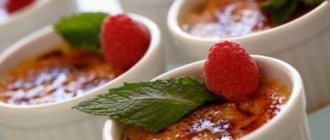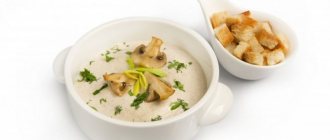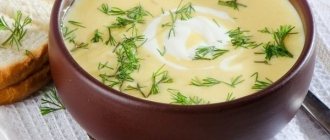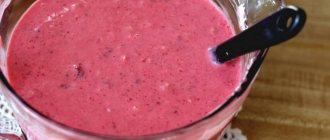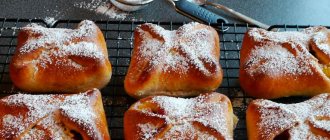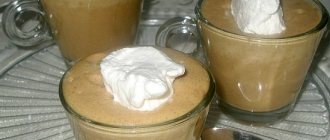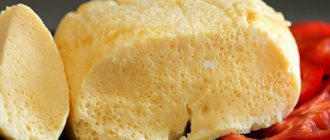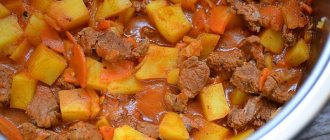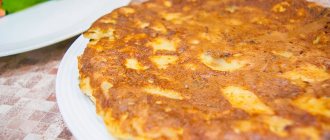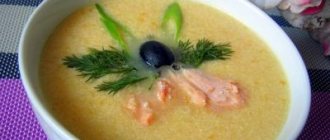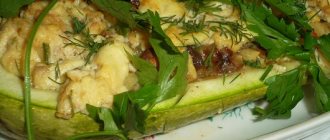No matter how many confectioners invent various sweets, no matter how hard they try to stand out with their creams and decorations, not a single recipe can compete with the classics. A cake or pastry with butter-based cream is guaranteed not to become boring.
Butter cream for cake - general principles of preparation
The basic rule for preparing any cream with butter is to use a fresh and exceptionally high-quality product, with the highest fat content. Poor-quality butter can separate when whipped, and if you use long-term stored butter, the dessert can quickly deteriorate.
An important condition is the exact observance of the proportions and sequence of mixing the products recommended in the recipe. You should not skimp on anything; if you violate the proportions, the cream, when whipped, as in the case of low-quality butter, may curdle or come out sparse. Such shortcomings are almost impossible to correct.
The third rule is that the cream should be used immediately after preparation. To avoid food poisoning, it is not recommended to store creamy masses for more than a day, even in the refrigerator.
Cream for cake at home - general principles of preparation
To get delicious cake cream at home, you should take fresh, high-quality and only natural products.
There are many types of cake cream and they differ greatly in preparation methods.
Cake cream at home is usually prepared by initially mixing all the ingredients and then whisking them until the desired thickness and consistency.
There are types of creams for which the base is first brewed, which is then added hot or cooled during the beating process to the rest of the ingredients, or, conversely, other components are combined with the already cooled or still hot brewed base.
Regardless of what type of cream is being prepared, there is a prerequisite: at the end of whipping, the result should be a homogeneous, thick mass that has increased several times. This, in fact, is the finished cream.
Butter cream for cake with caramel flavor
Delicate butter cream with a pleasant beige tint and caramel flavor. This mass is ideal for sponge cakes and dessert decoration. After cooling, when kept warm for a long time, it does not melt, the decorations hold their shape well and do not flow.
Ingredients:
a glass of sugar;
heavy, 35 percent cream – 300 ml;
a bag of vanilla powder;
150 high-quality, high-fat oil.
Cooking method:
Pour the sugar into a low double-bottomed saucepan or saucepan. Having distributed it in an even layer over the entire bottom, place the container on the lowest heat and, stirring, heat until all the crystals dissolve. Next, boil the syrup until the color changes; it should acquire a barely noticeable reddish tint. Do not over burn, otherwise the cream will taste bitter.
At the same time as the syrup, heat the cream on the next burner at the lowest possible heat.
Stirring the finished sugar syrup intensively in a circular motion, very carefully and slowly pour the hot cream into it. Lumps may appear immediately, do not stop boiling, they will dissolve when heated.
Remove the thickened creamy mixture from the stove and immediately pour it into a bowl. After cooling slightly, filter through a sieve and place in the refrigerator for a while, at least half an hour.
In a deep bowl, beat the chopped butter until shiny. Then, without ceasing to beat, add the cooled caramel base into it, spoonful at a time.
Butter cream recipe. Calorie, chemical composition and nutritional value.
Nutritional value and chemical composition of “Butter cream”.
The table shows the nutritional content (calories, proteins, fats, carbohydrates, vitamins and minerals) per 100 grams of edible portion.
| Nutrient | Quantity | Norm** | % of the norm in 100 g | % of the norm in 100 kcal | 100% normal |
| Calorie content | 472.8 kcal | 1684 kcal | 28.1% | 5.9% | 356 g |
| Squirrels | 4.9 g | 76 g | 6.4% | 1.4% | 1551 g |
| Fats | 34 g | 56 g | 60.7% | 12.8% | 165 g |
| Carbohydrates | 36.6 g | 219 g | 16.7% | 3.5% | 598 g |
| Organic acids | 0.3 g | ~ | |||
| Water | 22.6 g | 2273 g | 1% | 0.2% | 10058 g |
| Ash | 1.2483 g | ~ | |||
| Vitamins | |||||
| Vitamin A, RE | 256 mcg | 900 mcg | 28.4% | 6% | 352 g |
| Retinol | 0.231 mg | ~ | |||
| beta carotene | 0.151 mg | 5 mg | 3% | 0.6% | 3311 g |
| Vitamin B1, thiamine | 0.043 mg | 1.5 mg | 2.9% | 0.6% | 3488 g |
| Vitamin B2, riboflavin | 0.283 mg | 1.8 mg | 15.7% | 3.3% | 636 g |
| Vitamin B4, choline | 19.66 mg | 500 mg | 3.9% | 0.8% | 2543 g |
| Vitamin B5, pantothenic | 0.524 mg | 5 mg | 10.5% | 2.2% | 954 g |
| Vitamin B6, pyridoxine | 0.092 mg | 2 mg | 4.6% | 1% | 2174 g |
| Vitamin B12, cobalamin | 0.328 mcg | 3 mcg | 10.9% | 2.3% | 915 g |
| Vitamin C, ascorbic acid | 0.66 mg | 90 mg | 0.7% | 0.1% | 13636 g |
| Vitamin D, calciferol | 0.55 mcg | 10 mcg | 5.5% | 1.2% | 1818 |
| Vitamin E, alpha tocopherol, TE | 0.476 mg | 15 mg | 3.2% | 0.7% | 3151 g |
| Vitamin H, biotin | 2.097 mcg | 50 mcg | 4.2% | 0.9% | 2384 g |
| Vitamin RR, NE | 1.2483 mg | 20 mg | 6.2% | 1.3% | 1602 g |
| Niacin | 0.148 mg | ~ | |||
| Macronutrients | |||||
| Potassium, K | 244.31 mg | 2500 mg | 9.8% | 2.1% | 1023 g |
| Calcium, Ca | 205.28 mg | 1000 mg | 20.5% | 4.3% | 487 g |
| Magnesium, Mg | 22.41 mg | 400 mg | 5.6% | 1.2% | 1785 g |
| Sodium, Na | 87.59 mg | 1300 mg | 6.7% | 1.4% | 1484 g |
| Sera, S | 47.59 mg | 1000 mg | 4.8% | 1% | 2101 g |
| Phosphorus, Ph | 150 mg | 800 mg | 18.8% | 4% | 533 g |
| Chlorine, Cl | 155.93 mg | 2300 mg | 6.8% | 1.4% | 1475 g |
| Microelements | |||||
| Iron, Fe | 0.2 mg | 18 mg | 1.1% | 0.2% | 9000 g |
| Yod, I | 4.59 mcg | 150 mcg | 3.1% | 0.7% | 3268 g |
| Cobalt, Co | 1.31 mcg | 10 mcg | 13.1% | 2.8% | 763 g |
| Manganese, Mn | 0.0046 mg | 2 mg | 0.2% | 43478 g | |
| Copper, Cu | 19.66 mcg | 1000 mcg | 2% | 0.4% | 5086 g |
| Selenium, Se | 1.966 mcg | 55 mcg | 3.6% | 0.8% | 2798 g |
| Fluorine, F | 22.93 mcg | 4000 mcg | 0.6% | 0.1% | 17444 g |
| Zinc, Zn | 0.6966 mg | 12 mg | 5.8% | 1.2% | 1723 g |
| Digestible carbohydrates | |||||
| Mono- and disaccharides (sugars) | 36.6 g | max 100 g | |||
| Lactose | 8.1897 | ~ | |||
| Sucrose | 28.5 g | ~ | |||
| Essential amino acids | 1.8561 g | ~ | |||
| Arginine* | 0.1572 g | ~ | |||
| Valin | 0.2968 g | ~ | |||
| Histidine* | 0.1114 g | ~ | |||
| Isoleucine | 0.2739 g | ~ | |||
| Leucine | 0.3525 g | ~ | |||
| Lysine | 0.3538 g | ~ | |||
| Methionine | 0.1081 g | ~ | |||
| Methionine + Cysteine | 0.1507 g | ~ | |||
| Threonine | 0.1992 g | ~ | |||
| Tryptophan | 0.0622 g | ~ | |||
| Phenylalanine | 0.2097 g | ~ | |||
| Phenylalanine+Tyrosine | 0.4324 g | ~ | |||
| Nonessential amino acids | 2.9561 g | ~ | |||
| Alanin | 0.1546 g | ~ | |||
| Aspartic acid | 0.3472 g | ~ | |||
| Glycine | 0.0917 g | ~ | |||
| Glutamic acid | 1.0424 g | ~ | |||
| Proline | 0.511 g | ~ | |||
| Serin | 0.2739 g | ~ | |||
| Tyrosine | 0.2214 g | ~ | |||
| Cysteine | 0.0452 g | ~ | |||
| Sterols (sterols) | |||||
| Cholesterol | 85.17 mg | max 300 mg | |||
| Saturated fatty acids | |||||
| Saturated fatty acids | 21.9 g | max 18.7 g | |||
| Monounsaturated fatty acids | 1.6903 g | min 16.8 g | 10.1% | 2.1% | |
| 18:1 Oleic (omega-9) | 1.6183 g | ~ | |||
| Polyunsaturated fatty acids | 1.0717 g | from 11.2 to 20.6 g | 9.6% | 2% | |
| 18:2 Linolevaya | 0.1179 g | ~ | |||
| 18:3 Linolenic | 0.0393 g | ~ | |||
| 20:4 Arachidonic | 0.0524 g | ~ | |||
| Omega-6 fatty acids | 0.2 g | from 4.7 to 16.8 g | 4.3% | 0.9% |
The energy value of Butter Cream is 472.8 kcal.
Primary Source: Created in the application by the user. Read more.
** This table shows the average levels of vitamins and minerals for an adult. If you want to know the norms taking into account your gender, age and other factors, then use the “My Healthy Diet” application.
Butter cream for cake - cooking tricks and useful tips
When using whole condensed milk, it is advisable to strain it before mixing it with butter. If there are impurities in condensed milk, the cream will lose its homogeneity.
If the condensed milk is candied, preheat it in a water bath or in a saucepan at the lowest possible heat, then be sure to strain and cool.
What to do if the cream separates while whipping? You can try to correct this deficiency by cooling and re-beating the cream mass. If this method does not help, re-cool the cream and place it on a sieve so that the whey that has come out of the oil is completely drained.
Useful links:
Recipes for face creams with oils
When choosing the ingredients for these products and preparing them, you should consider your skin type and the purpose of their use. The best choice among oils would be apricot, grape, lavender, almond, olive and avocado. You can combine essential, cosmetic and regular herbal ingredients. For greater effect, it is recommended to warm them up before use. The prepared cream is applied to a thoroughly cleansed face until completely absorbed, but if the composition is too greasy, then it can be washed off after 10-15 minutes.
Face cream with apricot oil
To prepare this product you will need beeswax (2 tsp), natural unrefined apricot oil (3 tbsp), vegetable glycerin (1 tsp) and one egg yolk.
Work order:
- Break one egg and separate the yolk from the white, combining it with the rest of the ingredients.
- Beat the mixture well.
- Clean and steam the skin thoroughly.
- Using a brush, gently apply the product to your face.
- After 10 minutes, wash your face.
Ready-made apricot cream is recommended to be used to soothe and rejuvenate dry and sensitive skin no more than 2-3 times a week.
Face cream based on grape seed oil
It is very important that the main ingredient is fresh and not sour.
It is advisable to use an extract from the seeds of some green grapes, for example, the “Kishmish” variety. Instructions for preparing grape cream look like this:
- In a water bath, bring beeswax to a liquid consistency, which you will need 2 tsp.
- Combine the first ingredient with warm rose water (3 tbsp).
- Add heated oil (1.5 tbsp) to the mixture.
- Carefully pour in liquid Vaseline (2 tsp).
- Keep the resulting mixture on low heat for about 2 minutes.
- Let the product cool and lubricate clean skin with it, then leave for 10 minutes and then wash.
This face cream with oils thickens quickly, so to get a more delicate texture, you need to beat it with a blender before use.
Face cream with lavender essential oil
You will need animal and plant ingredients: homemade heavy cream (25 g), soy lecithin (1 tsp), alpha tocopherol ampoules (1.5 tsp), mineral water (15 ml) and lavender essential oil (2 tbsp.)
Here's how to do it right:
- First, combine the liquid ingredients.
- Warm up the mixture.
- Whip the cream and add it to the fat phase.
- Stir the product well, keep it in a warm place and slowly apply to the skin.
- Leave the mixture for 15 minutes and, when it is absorbed, wash with warm water.
Avoid getting lavender essential oil on the mucous membranes of your eyes, otherwise they will begin to burn and sting.
Face cream with olive oil
This recipe is suitable for sensitive, problematic skin with acne and other blemishes.
It involves the use of peeled cucumber pulp (2 tbsp), beeswax (3 tbsp), olive oil (2 tbsp) and potato starch (2 tsp). The product is prepared as follows:
- Mix all liquid ingredients.
- Melt beeswax (3 tbsp).
- Dissolve starch (15 g) in wax.
- Combine all ingredients and beat the mixture thoroughly.
- Apply the mixture to a cleansed face and rinse off any remaining residue after 15 minutes.
Olive cream is best used in the morning, immediately after washing with gel.
Face cream with avocado oil
This product perfectly moisturizes and soothes the skin.
To prepare it you need unrefined oil. The main condition is that it should be heated before use. The finished mixture must be beaten well with a blender or whisk. This is what the recipe itself looks like:
- Keep olive oil (2 tablespoons) over low heat.
- Mix the main ingredient with pure still mineral water (1.5 tbsp) and avocado pulp (1 tbsp).
- Carefully add 1 tsp into the mixture. glycerin.
- Whisk the mixture, soak a cloth in it and wipe your face with it.
You should use olive cream 2-3 times a week after thoroughly cleansing the skin with a scrub and steaming it.
Face cream with almond oil
The recipe proposed below is worth choosing for those who want to get rid of unsightly shine on the skin and increased oiliness.
The face cream with oils prepared using it will be enough for about 3-4 applications. Here's what to use and how to use it:
- Combine 3 tbsp. l. uncandied honey with lanolin (1 tsp), boiled water (1 tbsp) and raw almond oil (2 tbsp).
- Stir and beat the mixture with a mixer.
- Heat the mixture until it thickens.
- Cool the product and carefully, in a thin layer, apply it to your face.
- After 15 minutes, remove the mixture from the surface and wipe it thoroughly with a soothing lotion.
Honey irritates the dermis, so it is not suitable if it is sensitive.
Face cream with coconut oil
The product must be prepared immediately before use, from fresh ingredients.
The oil needs to be raw, the so-called first pressing. You can distinguish it from refined one by its thick consistency. This remedy is very simple to prepare:
- Lightly heat homemade heavy cream (10 ml).
- Melt coconut oil in a water bath (3 tbsp).
- Combine the first two ingredients and add fresh honey (1 tablespoon).
- Beat the egg yolk into the mixture.
- Stir the mixture and apply it to your face.
- Wash off the mixture after 15 minutes have passed.
Cream with coconut oil can be used every day; it is easily tolerated by the skin.
This remedy is especially useful for the lower and upper eyelids and lips. How to make a cream with oils - watch the video:
Using oils for facial care in their pure form is definitely not the best option. In practice, it has been proven that they can cause severe allergies and not only that. Therefore, the best way out of the situation is to use them to prepare cosmetics according to our recipes. We are sure that there are simply no better creams or oils for the face than we have described!
Custard for cake at home with condensed milk
Ingredients:
. “condensed milk” - half a can;
100 ml of any “factory” milk;
One egg;
50 grams of white flour;
Two hundred gram pack of unsalted butter, natural.
Cooking method:
1. Combine regular pasteurized milk with condensed milk, add eggs and mix everything thoroughly.
2. Add the flour while constantly whisking, making sure that no lumps form. If this still cannot be avoided, strain the mixture and stir well again.
3. Then place the stove on the stove at minimum heat. Constantly stirring the mixture, bring it until it thickens, but under no circumstances allow it to boil.
4. In a separate bowl, start beating the butter, cut into small pieces. When it softens well, add the custard mixture to it, little by little, about three tablespoons at a time. Do not add the next portion until the oil added earlier is completely incorporated.
